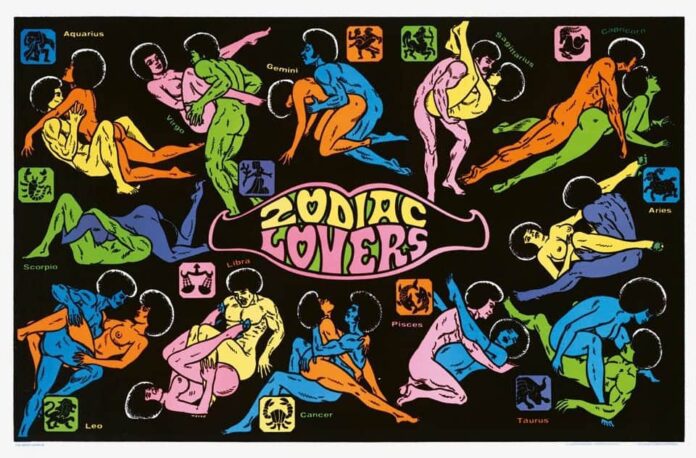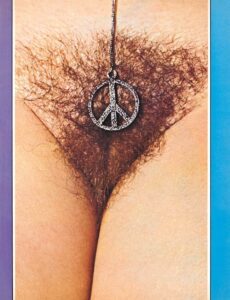Dian Hanson has made a career of “probing the subtleties of male lust.” In 1976, she began to edit such successful fetish magazines as Juggs, Oui, Leg Show, and Outlaw Biker. Pornography, at that time, had just gone through one of its more awkward phases. Amid the psychedelia and taboo-busting of the sexual revolution, men’s magazines weren’t sure how far to go in depicting free love; an industry built on forbidden fantasy risked being outpaced by real life.
That dilemma is at the heart of Psychedelic Sex, which catalogs, with more than four hundred pages of art, the attempts by men’s glossies to offer an authentic hippie sex trip. More than an exercise in kitsch, the book captures a shift in male sexuality—it reminds of a time when pornography and the stories it tells about our culture were completely different than they are today.
Hanson, who’s now the official “sexy editor” of Taschen Books, is uniquely informed, having seen pornography as a photo and text editor, an advice writer, an occasional model, and a true fan. From her home in Los Angeles, she spoke to me about changing mores, the contempt for pornography even among those who make and consume it, and the many misconceptions of the male psyche.
Psychedelic Sex is about magazines from the late sixties and early seventies, which you seem to have a vast knowledge of, even though you didn’t start editing magazines until 1976.
This book was an offshoot of my six-volume history of men’s magazines. When I was doing the fourth through sixth volumes of that, I hooked up with a collector in San Francisco—Eric Gotland, who was a rock manager. He made a lot of money with Third Eye Blind and used it to fulfill his adolescent fantasy of owning every issue of every men’s magazine ever made. Of course, once he started on this journey, he found that there were so many men’s magazines that it was impossible to buy them all. Still, he filled a warehouse in the Potrero Hill section of San Francisco with these magazines, buying like a lunatic on eBay and everyplace he could find them. I would go up there and go through the boxes with him, which was a joy. We started finding all this psychedelic stuff, and he was a particular fan of it—he’d been too young to be a part of the sexual revolution, but he was fascinated by it, as any ten-year-old boy would be. We decided that this would make a great book on its own, mapping this strange subgenre that tried to represent hippies and hippie sex and the drug experience for straight guys who felt left out of the whole sexual revolution. They went on from about 1967 to about 1973.
It does seem like there’s a remove from the magazines here and what you’re used to seeing as a representation of the movement. Do you feel like that’s common in pornography—that it exists at a remove from the culture?
Certainly it’s all inspired by the culture. But our sexuality is formed at an early age—four, five, six years old—and the guys who were looking at these magazines were guys from, say, the World War II generation. The things that were going to be triggers for them were no longer current by the late sixties. What you see are magazines made by other guys from that generation, sharing in a fantasy about the current time that doesn’t actuallyreflect the current time. It’s just like how we saw hippies in movies back in, say, the seventies—they didn’t look like hippies, they looked like Hollywood fantasies, idealized hippies, because they were concocted by fifty-year-old men dreaming, taking the Marilyn Monroe aesthetic and dressing it up in a fringe vest. By the time you’re actually expressing your sexuality, it’s already out of date. I can remember a man saying his sexuality came from lying on the floor watching TV westerns when he was a little boy, seeing women kidnapped and tied up and tied to the railroad tracks. By the time he grew up, it was the 1980s. Nothing like that was on television anymore. And yet this was still what aroused him. For pornography to hit his sweet spot, it had to be antiquated.
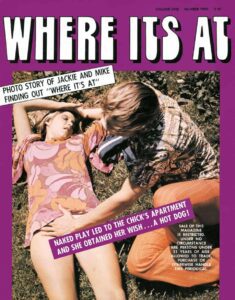
You’re something of an expert on sexual fantasy. What are your research methods?
Back when I was doing men’s magazines, people still wrote letters. I encouraged them to write me so I could better understand my audience, and they just flooded me with letters confessing their deepest secrets and looking for understanding and support from a sympathetic woman. When I was doing Leg Show, John Money, the sexologist, contacted me. He said, How do you get these people? How do you get them to open up to you?
They do it unbidden. They don’t want to talk to a psychiatrist, they don’t want to talk to a researcher, they don’t want to talk to some guy sitting there with a notepad. They want to talk to a woman who they find attractive, who they think is going to be sympathetic and might actually find them appealing.
Someone who can make their fantasies come true.
Exactly. I encouraged them in the activity they were most invested in with my magazines, and that was masturbation. They weren’t looking at these magazines to then go out and meet women and have consensual sex. These were guys who were living a fantasy life and living it all through masturbation. They felt very embarrassed and ashamed of that, but I was always sending them the message that it was okay, that it was normal—and, in fact, that all the women they saw in the magazine preferred men who looked at their pictures and masturbated.
Did you get a lot of feedback from the women you worked with about that?
We’d always talk about it, because I directed the photo shoots. I’d be working with models all the time, and I worked with a lot of female photographers and makeup artists. A photo shoot would very commonly be a bunch of women together, saying, Do this movement with your hand. When you do that, the guys think you’re encouraging them to masturbate. This was what we were there for. To arouse these guys and, in so doing, to make money.
You cornered the market, especially in fetish pornography. And you’re one of the only female editors who’s famous for doing this.
There were always a lot of other women working in the business, and I knew all these women, but most of them didn’t have my enthusiasm for the subject matter, my curiosity for exploring human psychology and sexuality. A lot of them didn’t like men the way I did. I found that working at the magazines made me like men more. The more I communicated with them, the more letters I read, the more I understood the male mind and the male approach to sexuality—it made them more likeable. I saw how romantic men were. I saw that sex, for most men, was really a supreme expression of love, that they didn’t disconnect it as most people believed. Certainly most of the other women I knew in the business thought that all these men were just out for the sex and they didn’t care. Men were always falling in love with these women in the magazines, sending them gifts, projecting idealized personalities onto them. I came to see that men and women approach these things differently—women are much more pragmatic about sex and love than men are. Men are probably the more romantic of the two, and certainly more likely to be deeply wounded if a relationship ends. I would hear from men who had confessed to their wives some unusual sexual interest, who had been rejected and had never tried to date a woman again, had never dared to speak to a woman about what they were interested in. Most men approach women with a kind of combination of fear and awe.
Much more attention, when it comes to porn, is placed on the psychological fallout.
I saw a common trajectory with young men we would hire, say, in the design department. They’d come in, and they’d be twenty-five to thirty years old, and they would be really excited that they were going to work with all of this sexual imagery. And they would dive deeply into it, become connoisseurs of it, taking it home and looking at it and probably masturbating a great deal themselves—I didn’t talk to them about that. But they’d get involved in it to the point that it would be annoying their girlfriends, annoying their wives, and alienating them. And then about six months into it, they would have had enough. They didn’t want to look at it anymore, and then they couldn’t relate to it. So they personalized it completely, and then became really almost useless working in the business because they were resentful toward the material. I think this is probably a common response from people who are not really porn fans. It’s a small percentage of the male population who are really die-hard porn fans—maybe 10 percent. Everyone likes to have a look at it, but the majority of people, if they see an unlimited supply, will get sated and bored and turn away from it.
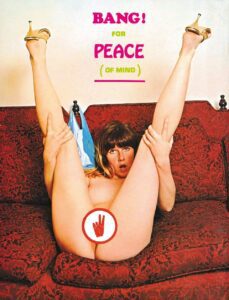
Do you see a difference in the way people interact with magazines and the way people interact with porn on the Internet?
Back when there were magazines, people had to make an effort to acquire their material. They had to go through the embarrassing experience of buying it and presenting it to a clerk, and they had to pay for it. It was never cheap. It was understood that this was something you should have to pay money for. It was like an expensive meal. If you wanted the good stuff, you paid accordingly. Then the Internet came along and made it all free, just devalued it completely. People can sit there and look at it on their lunch hours. The devaluation of the sexual imagery has probably devalued the sexual experience for a lot of people. Beyond that, there’s so much retouching done as a matter of course now, everywhere. People see these completely idealized bodies and they can become uncomfortable with the grim realities of human flesh. They’re mortified if they see cellulite, if they see a funny mole, if they see pubic hair, if they see a wrinkle. The sissification of young men in America from looking at these idealized images—it’s not like their fathers and their grandfathers, who were like, Okay, she’s fifty years old and she’s missing a leg but she’s available! I’m hard, I’m horny, I’m gonna have sex with her. We’ve made men, in particular, very, very picky. And at the same time, women have sort of gone back to the pre–sexual revolution era. They just think, All these guys are a bunch of pigs who just want to look at porn all the time. They’ve gone back to a sexual conservatism from all this material just being there. Young women I know consider a promiscuous woman a slut again. They’re interested in getting married and settling down and having children, and I see a lot of this as kind of a reaction against this porn-permeated culture.
I find it sexier to see the reality of people. This is why we produce the kind of books we do. You see the hair, you see the realism, and you see the faces. I don’t do erotic art books where you have a nude with her face tastefully turned away or out of the picture altogether—where you’ve just turned her body into a body-scape. That’s not sexy.
Would you say that’s the difference between fashion magazines and pornography?
Fashion magazines are the absolute opposite of good pornography. The women, for the most part, have their feminine qualities, their curves, obliterated. Beautiful women stripped of their allure—they’re there to hang clothes on. They really don’t even exist. Interestingly though, when you see men in fashion, the men generally have nice physiques, healthy physiques, and usually their appeal is magnified. It’s the women who are nullified.
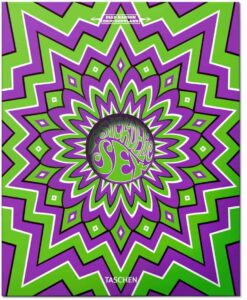
You’re interested in the narrative aspect of porn.
I always tried to have a story going in. I wanted there to be something behind it. Why is this woman here? Why is this woman taking her clothes off? What is she doing? I wrote, particularly in Leg Show, all the text that was in the magazine, everything that went along with the photographs—I would come up with the story before I did the photo shoot. We would follow that script, making something so the words and the pictures supported one another, to draw the viewer in, to make him feel included. There is a lot of pornography that is not inclusive. A lot of men told me that they felt ashamed after looking at pornography because they felt that it was made by other men who felt contemptuous of them and their needs. And they are absolutely right. A lot of it’s made by straight guys who know their job is to make other men masturbate, and that doesn’t make them feel very good about themselves. So they project that contempt into their magazine and into their work. I was a woman. I didn’t have a need for that contempt. I came to feel a kind of maternal affection for my readers, and they responded vigorously to that.
I remember a call I got from a man on his wedding day. His previous wife had died. He had never shared his foot fetish with her, and he felt devastated that he had lived with this woman, she had died, and he had never really told her what he was interested in. He felt he was never going to get another woman because he was a weirdo. I talked to him about how to bring it up with women and how to approach it. He met a new woman after a couple of years, he talked to me about her, I coached him again. He told her about it, she was accepting, he was so thrilled, and he called me on his wedding day saying, I just wish you could be here. It’s all because of you. Which isn’t a normal scenario for a pornographer.
Natasha Stagg is a senior editor at V and VMAN.
